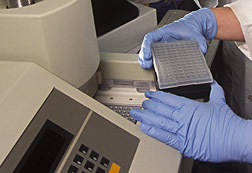| 
A highly specific new test that rapidly identifies
the "genetic fingerprints of various fungi that can cause
multimillion-dollar losses in western wheat is being developed. The information
from such tests sets the stage for a comprehensive risk-management database
that will help farmers decide how best to counter fungi problems. Click the
image for more information about it.
|
|

|
Scientists Identify Fungal Disease Culprits with
Molecular Genetics
By Jan Suszkiw
July 28, 2008 A new method that rapidly detects
the "genetic fingerprints" of fungi responsible for millions of
dollars in losses in western wheat has been developed by
Agricultural Research Service (ARS)
scientists in Pullman, Wash.
Though not ready for commercial use, the real-time quantitative polymerase
chain reaction (PCR) assays set the stage for building a comprehensive
risk-management database that will help farmers decide the best way to counter
the fungi, based on how many of them are present in the soil, as well as other
factors such as prevailing conditions, the type of crop grown, and other
variables.
Patricia
Okubara,
Timothy
Paulitz and
Kurtis
Schroeder at the
ARS
Root Disease and Biological Control Research Unit in Pullman developed the
assays, which now detect 10 Pythium and seven Rhizoctonia species. In May, the
team began collaborating with Harry Kreeft and Jim Torell, with
Western Laboratories of
Parma, Idaho, to explore the assays' commercial potential and eventual use in
gathering fungal data for the risk-management system.
In the Pacific Northwest, fungal diseases of seedlings and roots in spring
and winter wheat cost growers from $50 million to $70 million annually in yield
losses. In Washington State, Rhizoctonia root rot is so severe that some wheat
growers have abandoned the practice of direct-seeding, a planting technique
that conserves water and topsoil, notes Okubara.
The assay her team developed uses laboratory-built molecules called primers
to detect specific sequences of fungal DNA in soil or plant samples. The
primers bind with the sequences and prepare them for PCR amplification, which
generates millions of copies. A fluorescent signal that's measured and
displayed on a computer screen at each amplification cycle's end indicates how
much of the pathogen is present in the original sample.
The assays' chief advantages over conventional methods are speed,
specificity and sensitivity. Before, it was necessary to culture the fungi,
examine their features under a microscope and conduct greenhouse trials to
observe disease symptoms--a weeks-long process. The assays yield results in one
day.
ARS is a scientific research agency of the U.S. Department of Agriculture.